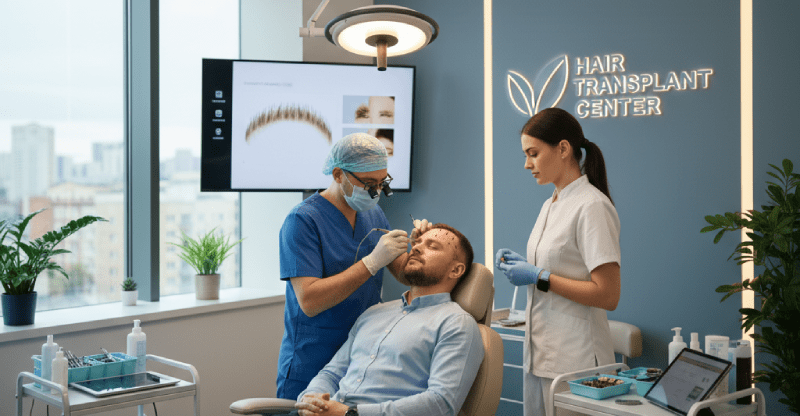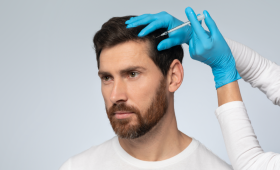What is Hair Transplantation?
Hair transplantation is the process of transplanting hair follicles that are genetically resistant to shedding, usually taken from the nape of the neck, to hairless or sparse areas. This procedure aims to give hair to hairless areas and to help the person have natural, dense hair. Hair transplantation offers a permanent and aesthetic solution for the problem of hair loss for men and women. Today, the most commonly used techniques are minimally invasive methods such as FUE and DHI.
Who is a Suitable Candidate for Hair Transplantation?
Suitable candidates for hair transplantation are primarily individuals with a sufficient amount of healthy donor hair follicles. The nape of the neck is generally used as the donor area. The main candidates are men experiencing genetic hair loss and women with thinning hair. In addition, they must be in good general health and not have any chronic illnesses such as uncontrolled diabetes or bleeding disorders. As it is a surgical procedure, being over 18 years of age is also a criterion.
What Are the Hair Transplantation Methods?
Today, the most commonly used hair transplantation methods are FUE (Follicular Unit Extraction) and DHI (Direct Hair Implantation). In the FUE method, hair follicles are taken one by one from the donor area and transplanted into the channels opened in the hairless area.
In the DHI method, a special pen (Choi implanter pen) is used to place the hair follicles directly into the transplantation area. Both methods have their own unique advantages and disadvantages. Which method is most suitable is determined according to the patient’s hair structure and needs.
Is Hair Transplantation a Painful Procedure?
The hair transplantation procedure is generally performed under local anesthesia, so the patient does not feel any pain. A slight stinging sensation may be felt during the anesthesia injections, but this sensation is short-lived. During the procedure, the patient remains awake and can comfortably listen to music or watch a movie. In the post-operative period, there may be a slight sensitivity and soreness, but this condition is easily controlled with the painkillers prescribed by the doctor.
How Long Does the Hair Transplantation Procedure Take?
The duration of the hair transplantation procedure varies depending on the number of hair follicles to be transplanted and the technique used. An average session takes between 4 to 8 hours. This time includes lunch and short breaks. If a high number of grafts like 4000-5000 is to be transplanted, the duration may be longer. The duration of the procedure can also vary depending on the experience of the surgical team and the condition of the patient’s donor area.
How Does the Recovery Process Work?
The recovery process after hair transplantation is generally quite fast. In the first few days, scabbing, redness, and swelling may be seen in both the donor area and the transplanted area. These symptoms begin to decrease within a week. It takes about 10 days for the transplanted hair follicles to take hold in their new places. Full recovery and the shedding of the scabs are completed in an average of 10-14 days. During this process, meticulous adherence to the doctor’s instructions is of vital importance for the success of the outcome.
When Do the Results Become Visible?
The full appearance of the hair transplantation results requires a process. Approximately 80% of the transplanted hair enters a phase called shock hair loss within the first 2-4 weeks and sheds. This is a normal situation and should not cause concern. The transplanted hair starts to grow again after 3-4 months. While most of the hair has grown by the end of 6 months, it is necessary to wait 12-18 months for the final and full result.

Is Hair Transplantation a Permanent Solution?
Yes, hair transplantation is a permanent solution. The reason for this is that the hair follicles used for transplantation are genetically resistant to shedding. These follicles are usually taken from the nape of the neck, and the hair in this area does not shed throughout life. They retain these characteristics when transplanted to their new places and do not shed. Therefore, the results obtained with the hair transplantation procedure are permanent for life and are in harmony with the person’s natural hair.
Do Scars Remain After Hair Transplantation?
Minimal scars may remain depending on the hair transplantation method. In modern techniques such as FUE and DHI, since the hair follicles are taken one by one, a linear scar does not form. In the donor area, microscopic dot-shaped scars remain where the hair follicles were taken, but these scars are almost invisible even with short hair. With the right technique and an experienced surgeon, the scars are minimized.
What Are the Side Effects After Hair Transplantation?
The side effects that can be seen after hair transplantation are generally mild and temporary. The most common side effects include swelling, redness, itching, and mild pain in the operation area. In addition, there may be some numbness in the donor area. These side effects usually disappear on their own within a few days. The risk of infection is very low if hygiene rules are followed.
What Should Be Considered Before the Operation?
There are a few important points to consider before a hair transplantation operation. It is necessary to stop using blood thinners, alcohol, and cigarettes at least one week before the procedure. Smoking can narrow blood vessels, reducing blood flow and negatively affecting the healing process. On the day of the operation, comfortable clothes should be worn, breakfast should be eaten, and caffeinated beverages should be avoided. These simple precautions increase the success of the surgery.
What Should Be Considered After the Operation?
The first few days after hair transplantation are very important. The donor and transplanted areas should not come into contact with water within the first 24 hours after the operation. You should sleep with your head elevated and avoid sudden movements. The medications recommended by the doctor should be used regularly, and the first wash should be done professionally. Hygiene rules must be strictly followed to reduce the risk of infection. For the first 10-14 days, contact with the transplanted area should be avoided until the scabs fall off.
Can Women Have Hair Transplantation?
Yes, women can also have hair transplantation. Hair transplantation can be a successful solution for women experiencing female pattern hair loss or severe hair thinning. Hair transplantation in women is generally done by transplanting hair follicles taken from the donor area between the existing hairs, and this procedure can also be performed without shaving. This allows women to return to their daily lives more quickly.
What Factors Affect Hair Transplantation Prices?
Hair transplantation prices vary depending on many factors. The most important factors include the number of grafts to be transplanted, the technique to be used (FUE or DHI), the experience of the clinic and surgeon performing the operation, the location of the clinic, and the additional services offered. Therefore, the most accurate approach is to have a preliminary examination and create a personalized treatment plan to get a clear price.
Is Shaving-Free Hair Transplantation Possible?
Yes, shaving-free hair transplantation is a possible option. In this method, which is generally applied with the DHI technique, the hair in the donor area is shaved in small windows and camouflaged between the existing hairs. This preserves the overall hair appearance, and it is not very obvious that the operation has been done. Shaving-free transplantation is especially preferred by individuals with long hair and women. This method is more suitable for cases where the number of grafts to be transplanted is limited.
Can Beard or Body Hair Be Used?
Yes, in cases where the donor area is insufficient, beard or body hair can also be used for hair transplantation. Generally, when the donor area is not sufficient, chest hair or beard hair is used as an addition. Beard hair, having a thicker structure, can provide a fuller appearance on the scalp. However, the growth cycles and structures of beard and body hair are different from the hair on the scalp. This method is an option for patients who need additional hair follicles.
What is Shock Hair Loss?
Shock hair loss is the temporary shedding of a large portion of the transplanted hair follicles after the hair transplantation procedure. This is a resting phase that the hair follicles enter to adapt to their new places. It begins within 2 to 4 weeks after the operation and lasts for about a few weeks. Shock hair loss is a natural part of a successful hair transplant and is not a cause for concern. New and permanent hair will grow in place of the shed hair.
When Can I Return to Work?
The time to return to work after hair transplantation varies depending on the type of work. For those working in an office environment, it is generally possible to return to work after 1-2 days. However, it should be noted that the head will be swollen and there will be scabbing for the first few days. This period may be longer for those working in a physically demanding job. It is important to follow the time recommended by the doctor so as not to disrupt the healing process.
When Can I Start Exercising?
The time to start exercising after hair transplantation is limited to the first 2 weeks after the operation. In the first week, only activities like light walking can be done. Heavy exercises, activities that cause sweating, and sports that can lead to an impact should be avoided for at least one month to prevent the hair follicles from moving out of place. It is especially necessary to wait 1 month to go to the pool or the sea.

Is a Second Hair Transplantation Possible?
Yes, a second hair transplantation procedure is possible. If the patient has enough hair follicles in the donor area, a second operation can be planned 1 year after the first transplantation. This procedure is usually done to fill in the remaining gaps after the first transplant or to achieve an even denser appearance.
How Should the Clinic/Surgeon Be Chosen?
Choosing a clinic and a surgeon is the most critical step for the success of the hair transplantation operation. Before making a decision, the clinic’s and the surgeon’s experience, references, and patient reviews should be examined in detail. It is important that the clinic provides services in a hygienic and modern environment, that the operation is performed by an expert team, and that pre- and post-operative follow-up is carried out meticulously.
Is Hair Transplantation a Safe Procedure?
Hair transplantation is a very safe procedure when performed under the right conditions and by an experienced surgeon. Since it is a procedure performed under local anesthesia, it does not carry the risks of general anesthesia. The risk of a serious side effect or complication is very low. However, when done in unsterile environments or by inexperienced people, the risks of infection and bad outcomes can increase.
How Long Do the Transplanted Hairs Last?
The transplanted hairs are permanent for life because they are naturally resistant to shedding. These follicles, taken from the nape and sides of the head, are immune to the genetic factors that cause hair loss. These follicles retain this characteristic in their new places. Therefore, the hair obtained with a successful hair transplant does not shed except for natural shedding due to the aging process.
When and How Should the Hair Be Washed?
The first wash after hair transplantation is usually done by the clinic 2 or 3 days after the operation. The first wash is performed with special shampoos and lotions and with very gentle movements to protect the sensitive transplanted area. In the following days, the patient should wash their hair according to the doctor’s instructions. Until the scabs have completely fallen off, pressurized water should not be applied to the transplanted area, and it should not be rubbed hard.
Can I Wear a Hat After Hair Transplantation?
It is not recommended to wear a hat for the first few days after hair transplantation because the transplanted area is sensitive. It is generally allowed to wear a hat 10-14 days after the operation, that is, after the scabs have completely fallen off. During this period, it is important to protect the transplanted area from the sun and external factors. The hat should be loose and made of a soft fabric that will not put pressure on the transplanted area.
What is the FUE Method?
The FUE (Follicular Unit Extraction) method is the process of taking hair follicles one by one from the donor area using a special micro motor or manual tools. This method allows a single hair follicle (graft) to be taken with a very small needle tip. The taken grafts are then placed into the channels previously opened in the transplantation area. This method is one of the most popular and modern hair transplantation techniques because it does not leave a linear scar.
What is the DHI Method?
The DHI (Direct Hair Implantation) method, unlike FUE, is the process of taking and transplanting hair follicles in a single step using a special pen (Choi implanter pen). The tip of this pen is thin and pointed and performs both the channel opening and hair follicle placement at the same time. This method is less traumatic because there is no need to open channels in the hairless area and provides a faster recovery.
Which Method is Better?
Which method is better depends on the patient’s individual needs and hair structure. FUE offers the possibility of transplanting a larger number of grafts to wide areas faster, while DHI provides more precise transplantation and hair density. Both methods have their own unique advantages. To determine the most suitable method, it is necessary to consult a specialist and analyze the hair structure and expectations in detail.
Can Transplanted Hair Be Dyed or Cut?
Yes, the transplanted hairs also grow, can be cut, and can be dyed just like your other natural hairs. However, for dyeing and other chemical treatments, the healing process must be completed, and the transplanted area must have fully healed. Generally, hair can be dyed 6-8 months after hair transplantation. For hair cutting, it is enough to wait 1 month after the operation.
Is There Pain or Swelling After Hair Transplantation?
It is normal to have pain and swelling after the hair transplantation procedure. Due to the sensitivity of the hair follicles taken from the nape of the neck and transplanted, there may be mild pain and swelling. This condition is controlled by sleeping with the head elevated and using the painkillers recommended by the doctor. Swelling usually peaks within the first few days and begins to decrease within a week.
Is It Safe To Get A Hair Transplant In Turkey?
Turkey is a highly developed country in the field of health. Patients from many countries generally prefer Turkey for all kinds of medical interventions. Turkey is the best choice for better quality and affordable treatments, especially considering its prices in other countries. The devices used in clinics in Turkey are devices with the latest technology. Hygiene is given great importance in clinics and a sterile environment is always provided. Surgeons are successful and most experienced people in their field. For this reason, being treated in Turkey is as safe a choice as possible.
Advantages Of Hair Transplantation In Turkey
There are many advantages of getting a hair transplant in Turkey. One of them is to give very high quality hair transplant treatment. It also does this at very affordable prices. Other advantages are that it has many places to visit and see due to its location, and this will allow you to have a holiday during your trip. The cost of living is low. You will not have to spend extra during your stay in Turkey.
Why Is It Cheap To Get Hair Transplant Treatment In Turkey?
The cost of living in Turkey is low. For example, if the clinic rent is 2000 euros and 3000 euros for personnel expenses are considered in another country, a cost of around 5000 euros arises. In Turkey, a clinic’s rent is 300 euros and personnel expenses are 1500 euros. That is, it is possible to run a clinic for 1800 euros on average. This high price difference is reflected in the hair transplant treatments at a very high rate. At the same time, the exchange rate in the country is quite high. This is a huge advantage for the harvests coming from abroad.
What Are the Price Determining Factors In Hair Transplantation?
Generally, prices in the country vary with a wide variety of factors, from operation, city, team and number of grafts. However, in order to offer more affordable and quality treatments, we give a single price for patients, ignoring price-determining factors both in the world and in Turkey.
Is It Safe To Get A Hair Transplant In Other Cheap Countries?
Hair transplantation is a very important treatment. If the necessary care is not taken, it can cause many problems, and it may not be safe to receive treatment in countries where you have only heard of it cheaply. It requires enough research. Health should never be left to chance. Some of the patients coming to Turkey consist of patients who received treatment in other countries but did not get any results. Getting treatment in another country and not getting results is the best chance. You just spend your money. However, if it is done incorrectly, it can lead to bigger problems such as infection and loss of already existing hair.
What Makes Turkey Different From Other Countries?
Compared to other countries, it is quite good in terms of quality and price. Many countries have to pay multiple times for consultation, treatment and post-treatment check-ups. In fact, this is mostly the case in Turkey. However, as Cure Holiday, we are in favor of pleasing patients rather than overpaying, so we do not overcharge patients and cover all services at a single price. In terms of quality, it is known all over the world that Turkey gives first quality treatment in hair transplantation. This explains Turkey’s success.
2022 Hair Transplantation Costs In Turkey
Accommodation in a first class hotel for 2 days + transfer fee is 1450 Euros, without the number of grafts in hair transplantation, with Cure Holiday.


